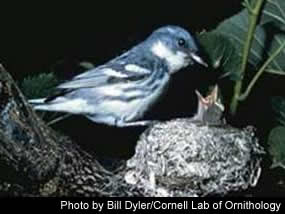

WILDLIFE DIVERSITY NOTEBOOK: The Cerulean Warbler Common Name: Cerulean Warbler
Scientific Name: Dendroica cerulea (den-DROY-ka sir-RUE-lee-ah)- from the Greek word dendron meaning tree, probably referring to its preference for tall trees, and the Latin word caeruleus meaning dark blue, in reference to color of the male bird. Status: The U.S. Fish and Wildlife Service is currently conducting a status review for the potential listing of the cerulean warbler as a threatened species. The Partners in Flight Working Group lists the cerulean warbler as a high priority species of concern. Status: West Virginia supports the highest densities of cerulean warblers anywhere in the species' breeding range. In the Ohio Hills Physiographic Region of West Virginia it is one of the most common breeding warblers. Despite being a common breeding bird in West Virginia, cerulean warbler populations are presently in decline. Breeding Bird Survey data from 1966 to 1998 indicate that the cerulean warbler has declined at an average rate of 3.6 percent per year throughout its breeding range, the greatest of any warbler species. In West Virginia , this decline is much less at 2.3 percent per year. Even though the cerulean warbler is in decline, it still occurs at such high densities in the state that birds nesting in West Virginia provide a source population to the surrounding region. This means that birds fledged in the state can populate other states. Description: The cerulean warbler, the smallest warbler in the genus Dendroica, measures 4.5 inches (11.5 cm) in length. It has a short tail and relatively long wings for a warbler of its size. In breeding plumage, the male cerulean warbler has bright blue upper parts streaked with black, a white underside, and a thin black “necklace” around its neck. The female is much duller than the male with a dull blue to greenish head and back, and a dull white to dull yellow underside. The female also lacks the distinctive black “necklace” of the male. Range: The cerulean warbler is a neotropical migrant that breeds in eastern North America and winters in South America. The main breeding range of the cerulean warbler extends from central Minnesota and southern Canada east to Connecticut and Massachusetts south to North Carolina and west to Arkansas. The heart of the breeding range occurs along the Mississippi and Ohio River valleys and within the Cumberland Plateau of West Virginia and Kentucky. In West Virginia this species occurs mainly west of the Allegheny Mountains in the Ohio Hills Physiographic Region, with the highest numbers inhabiting the southwestern portions of the state. It occurs less frequently in the Eastern Panhandle and it is uncommon within the Allegheny Mountains. The cerulean warbler winters in mixed species flocks on the eastern slopes of the Andes Mountains from Columbia to Peru, Bolivia, and the montane forests of Venezuela. Habitat: The cerulean warbler requires large tracts of mature deciduous forest with a closed canopy and many large tall trees. It lives in a variety of forest types including bottomland forests, moist cove forests and dry upland forests. Although it is poorly understood, the vertical structure of the canopy, sub-canopy, middle and understory layers within the forest also seem to be an important habitat factor. Diet: The cerulean warbler is largely an insectivorous feeder, gleaning insects from the dense foliage of deciduous vegetation. This species tends to forage high in the canopy gleaning slowly from the tree trunks outward. The primary food items taken include adult and larval butterflies and moths, beetles, weevils, fireflies, ants and leafhoppers. Life History: Beginning in late March the cerulean warbler leaves its wintering grounds in South America. It usually arrives in West Virginia around the last week of April. The female builds a compact cup-shaped nest high in the canopy, usually on a horizontal limb. Two to five gray to greenish-white, small, brown spotted eggs are laid and incubated by the female. The onset of brooding and incubation and the length of incubation are poorly understood. Both the male and female feed and care for the young. The cerulean warbler begins its fall migration south leaving West Virginia throughout the month of August. This species arrives on its wintering grounds during late August and September. Threats and Prospects: Several factors are contributing to the decline of the cerulean warbler. Among these are loss of habitat on the species' breeding and wintering grounds due to logging and agricultural clearing, loss of habitat on important migratory stopover locations, and habitat fragmentation of existing contiguous forest. Also, changes in forestry practices allow shorter stand rotation and even-aged stand management, eliminating the tall trees that cerulean warblers require. Biologists also believe that brood parasitism (when another species takes over the nest) by the brown-headed cowbird may play a role. Even though cerulean warbler populations are declining, West Virginia is a stronghold for this species. At the present time, cerulean warblers are an abundant breeding bird in much of West Virginia but habitat loss here and throughout its range are causes for concern. Compiled by the Wildlife Diversity staff. |
